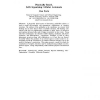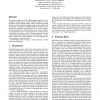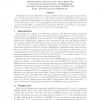107 search results - page 11 / 22 » Clandestine Simulations in Cellular Automata |
DAI
1998
Springer
13 years 11 months ago
1998
Springer
A physically based system of interacting polyhedral objects is used to model self-assembly and spontaneous organization of complex structures. The surfaces of the polyhedra in the ...
CA
2003
IEEE
14 years 23 days ago
2003
IEEE
We present a simple, linear 3D cellular automata approach for animating the melting process of solid volumetric models. Accurate modelling of object melting usually requires compl...
RAS
2006
13 years 7 months ago
2006
Self-reconfigurable robots are built from modules, which are autonomously able to change the way they are connected. Such a robot can, through this self-reconfiguration process, c...
CIT
2006
Springer
13 years 11 months ago
2006
Springer
CA are useful tools in modeling and simulation. However, the more complex a CA is, the longer it takes to run in typical environments. A dedicated CA machine solves this problem by...
DFT
2008
IEEE
14 years 1 months ago
2008
IEEE
Tolerating defects and fabrication variations will be critical in any system made with devices that have nanometer feature sizes. This paper considers how fabrication variations a...



